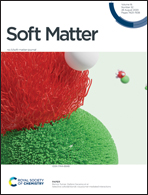Selective colloidal bonds via polymer-mediated interactions
Abstract
Regioselectivity in colloidal self-assembly typically requires specific chemical interactions to guide particle binding. In this paper, we describe a new method to form selective colloidal bonds that relies solely on polymer adsorption. Mixtures of polymer-coated and bare particles are initially stable due to long-ranged electrostatic repulsion. When their charge is screened, the two species can approach each other close enough for polymer bridges to form, binding the particles together. By utilizing colloidal dumbbells, where each lobe is coated with polymer brushes of differing lengths, we demonstrate that the Debye screening length serves as a selective switch for the assembly of bare tracer particles onto the two lobes. We model the interaction using numerical self-consistent field lattice computations and show how regioselectivity arises from just a few nanometers difference in polymer brush length.



 Please wait while we load your content...
Please wait while we load your content...